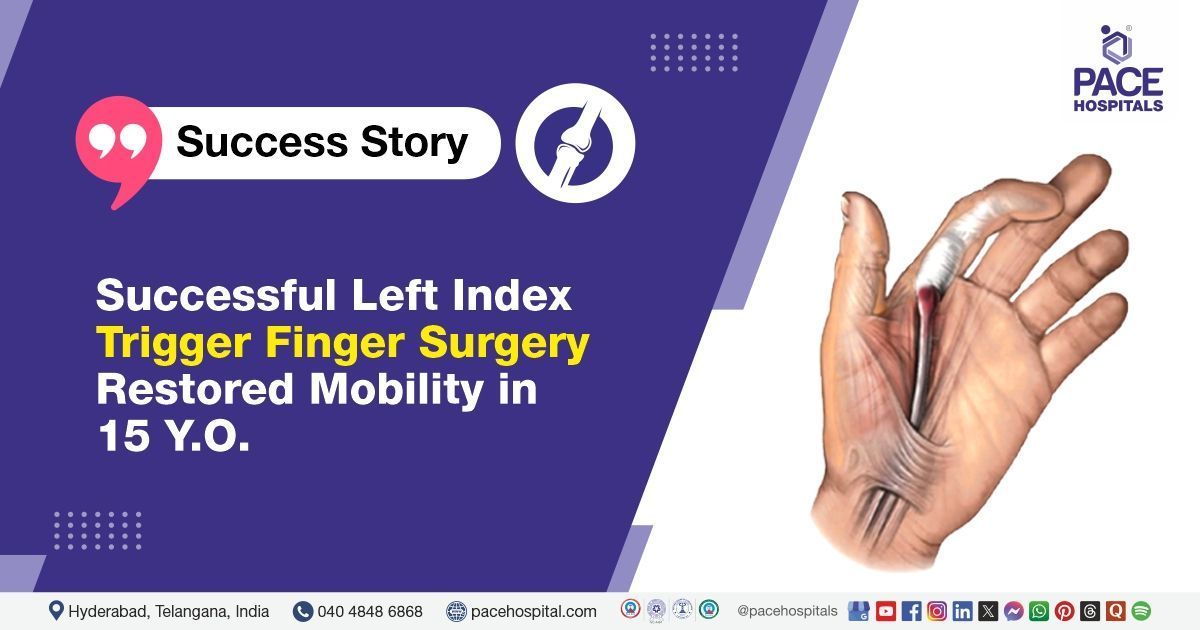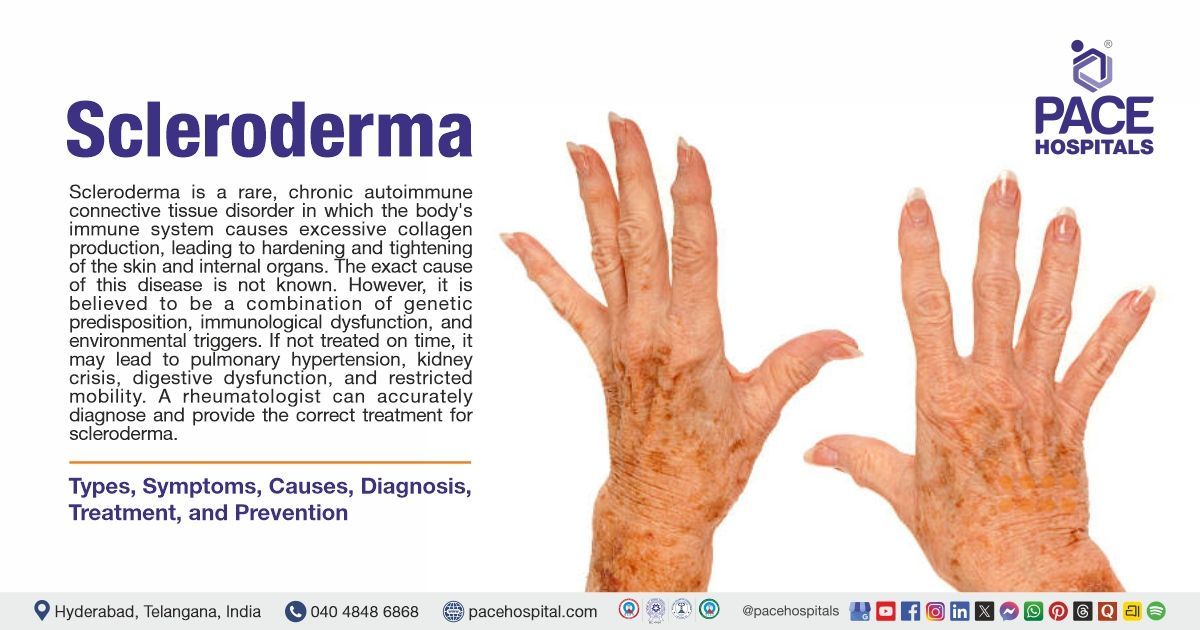Successful Left Index Trigger Finger Surgery Restored Mobility in 15 Y.O.
PACE Hospitals
PACE Hospitals' expert Orthopaedic team performed a Trigger Finger Release under Wrist block Anaesthesia on a 15-year-old male patient who presented with complaints of pain over Left index finger associated with difficulty in movement at the meta carpo pharyngeal (MCP) joint. The procedure was aimed at relieving his pain, improving his mobility, and enhancing his functional recovery.
Chief Complaints
A 15-year-old male patient with a
Body Mass Index (BMI) of 22.4 presented to the Orthopaedic Department at
PACE Hospitals, Hitech City, Hyderabad, with complaints of pain in his left index finger. He reported experiencing significant discomfort, particularly around the metacarpophalangeal (MCP) joint, which had gradually led to difficulty in finger movement. The symptoms had affected his ability to perform routine hand functions. Clinical evaluation suggested a trigger finger, necessitating further intervention.
Past Medical History
The patient had no history of
diabetes,
hypertension, trauma, or chronic illnesses, and no known drug allergies. His symptoms were suggestive of primary trigger finger, likely due to localized tendon inflammation.
On Examination
Upon admission to PACE Hospitals, the patient's vital signs were found to be stable on examination. A hard, globular swelling was noted on the palmar aspect of the left hand, around the palmar crease. The area was tender to touch, and the range of motion at the left index finger’s metacarpophalangeal (MCP) joint showed painful and restricted extension. There was no evidence of distal neurovascular deficit, indicating intact circulation and nerve function in the affected limb.
Diagnosis
Following the examination, the Orthopaedic team conducted a comprehensive assessment, including a detailed review of the patient’s medical history and clinical findings. Based on the characteristic symptoms including localized pain, swelling, tenderness, and restricted movement, a provisional diagnosis of Trigger Finger affecting the left index finger was made.
To support clinical findings, imaging studies were carried out. X-rays of the left hand, including anteroposterior (AP), lateral, and oblique views, revealed soft tissue changes consistent with the trigger finger involving the left index finger. These radiographic findings aligned with the patient's symptoms and confirmed the provisional diagnosis, guiding the team toward appropriate surgical intervention.
Based on the confirmed diagnosis, he was advised to undergo Trigger Finger treatment in Hyderabad, India, under the care of the Orthopaedic Department, ensuring comprehensive management of the fracture.
Medical Decision Making (MDM)
Given the patient’s symptoms, functional limitations in daily activities, and the confirmed diagnosis of the left index trigger finger, surgical intervention was deemed essential.
After a detailed discussion with the patient and his guardians, Dr. Anand V. Agroya, Consultant Orthopaedic Surgeon, recommended Trigger Finger Release as the most appropriate and effective treatment to achieve optimal stabilization and facilitate recovery.
The patient and his family were thoroughly counseled about the nature of the condition, the surgical procedure, potential risks, and the necessity of Trigger Finger Release to restore function and stabilize the left index finger.
Surgical Procedure
Following the decision, the patient was scheduled for a Trigger Finger Release surgery in Hyderabad at PACE Hospitals, under the expert supervision of the orthopaedic Department, ensuring optimal care and a smooth recovery process.
Before surgery, the medical team ensured the patient was stable and obtained informed consent from his guardians. A thorough pre-operative evaluation, including a pre-anesthesia check-up, was conducted to assess his fitness for the procedure and ensure safe management for optimal recovery.
During the procedure, the surgical site over the palmar aspect of the left index finger was aseptically prepared and draped. A small longitudinal incision was made to expose the flexor tendon sheath. The thickened A1 pulley (thickened or inflamed band of tissue) was identified, incised, and released to relieve the tendon constriction causing the trigger finger. The tendon was checked for smooth gliding. Hemostasis (bleeding control) was achieved, and the incision was closed in layers with absorbable sutures.
Postoperative Care
The postoperative period was uneventful, with no complications observed. After the surgery, the patient was transferred to the general ward, where intravenous antibiotics and analgesics were administered to prevent infection and manage pain. Supportive care was provided as needed to ensure a smooth recovery. The surgical wound was closely monitored and appeared healthy, with no signs of infection or abnormal swelling.
The patient showed symptomatic improvement and was prepared for discharge with detailed post-discharge care instructions and follow-up recommendations.
Discharge Medication
Upon discharge, the patient was prescribed a combination of medications to aid recovery and prevent potential complications. Oral antibiotics were prescribed to prevent infection, while analgesics were recommended for pain management. Additionally, proton pump inhibitors were given to reduce gastric acidity and protect against potential stomach irritation from pain medications. Other supportive treatments, including instructions for wound care and gradual mobilization exercises, were also provided to facilitate the patient's recovery and restore function to the affected finger.
Advice on Discharge
The patient was instructed to avoid excessive stress on the left hand and refrain from sports activities for at least 15 days to ensure proper healing.
Emergency Care
The patient was informed to contact the Emergency ward at PACE Hospitals in case of any emergency or development of symptoms such as fever, abdominal pain, and vomiting.
Review and Follow-Up
The patient was advised to return for a follow-up visit with the Orthopaedic Department at PACE Hospitals after 3 days for a dressing change, with suture removal scheduled after 8–10 days, and for further evaluation.
Conclusion
This case demonstrated the effectiveness of trigger finger release surgery in treating the left index trigger finger, providing significant symptom relief, faster recovery, and a reduced risk of complications.
Significance of trigger finger release in the management of trigger finger
For patients who have not responded adequately to conservative treatments such as splinting, trigger finger release surgery is a highly effective option for managing the condition. According to an orthopaedic doctor / orthopaedic surgeon, when non-surgical methods fail to relieve symptoms or when finger function becomes significantly impaired, surgical intervention becomes necessary. The procedure directly addresses the underlying cause of the constriction of the A1 pulley by releasing the tight band around the flexor tendon. This release allows for smooth tendon movement, reduces pain and locking, and helps restore normal finger mobility and strength. As a result, trigger finger release surgery offers reliable and lasting relief for patients with persistent or severe symptoms unresponsive to other treatments.
Share on
Request an appointment
Fill in the appointment form or call us instantly to book a confirmed appointment with our super specialist at 04048486868











